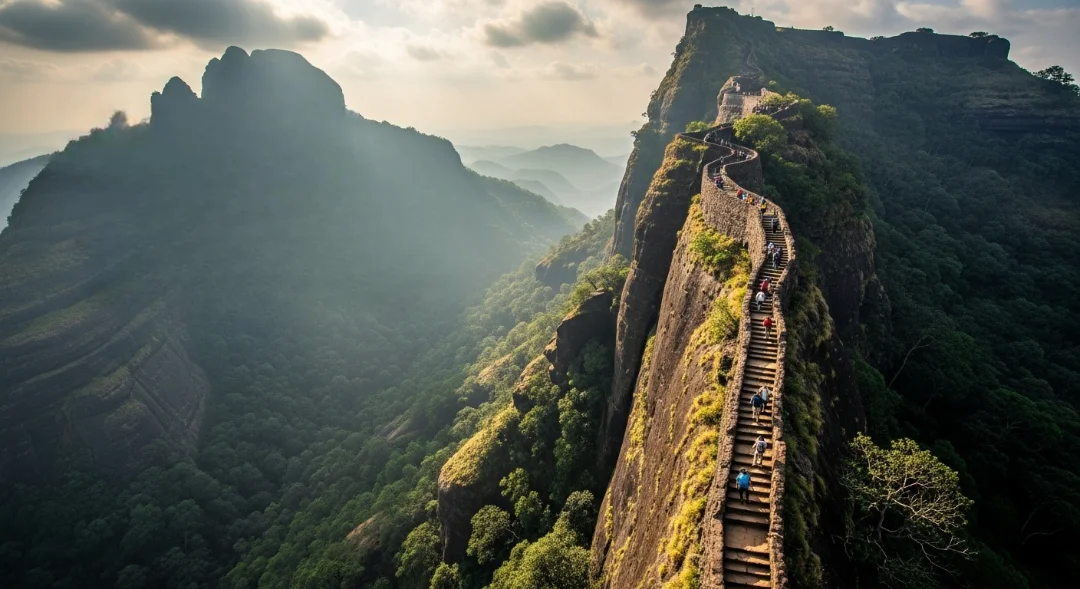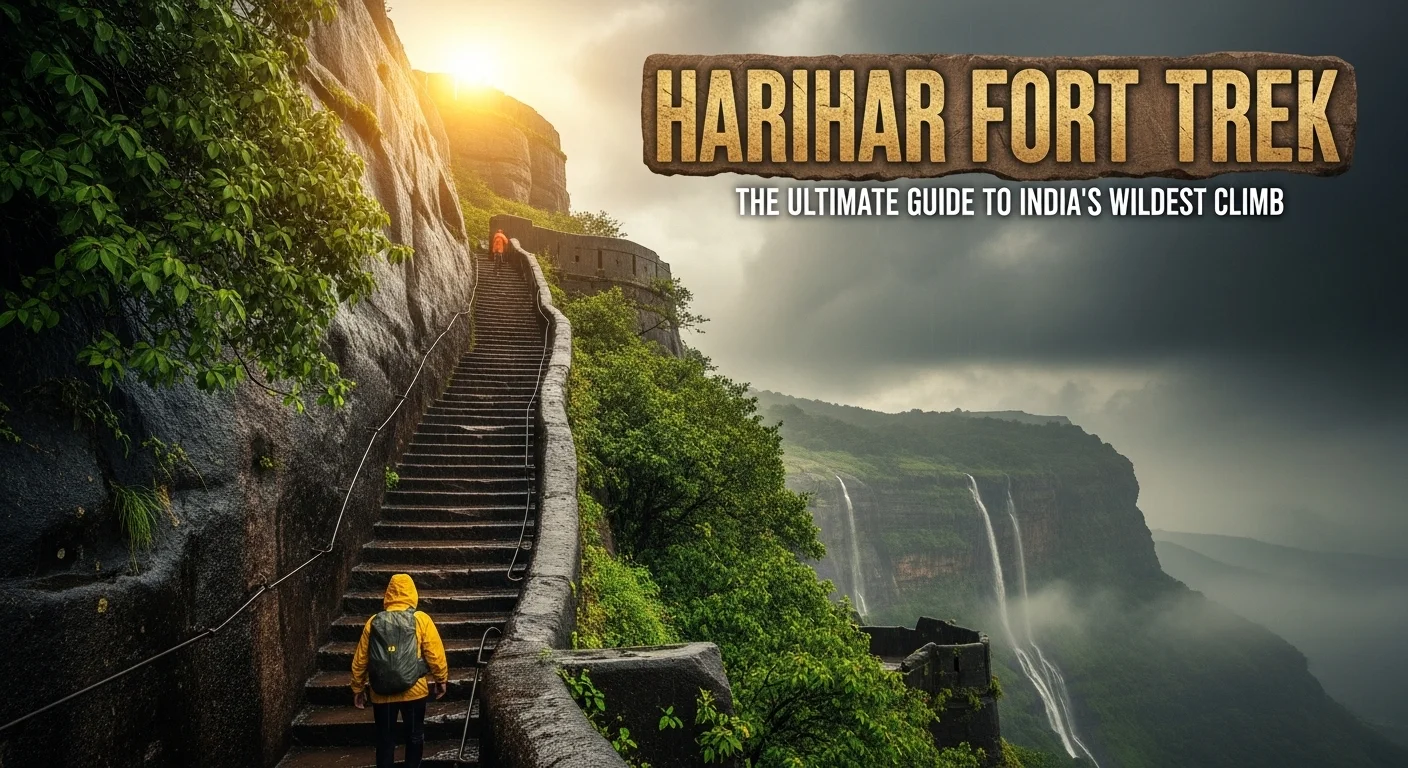Nestled within the rugged peaks of the Sahyadri mountain range in Maharashtra lies a fortress that has become a legend among trekkers. Harihar Fort, also known as Harshagad, is no ordinary hill fort. It is an adventure seeker’s pilgrimage, renowned for a nearly vertical rock-cut staircase that has earned it the title of India’s wildest climb. This trek is a true test of grit, offering an exhilarating journey that combines historical exploration with a thrilling physical challenge. This article is your comprehensive Harihar Fort travel guide, providing all the essential information to prepare for and safely conquer this iconic climb.
Trek Overview: What Makes it “India’s Wildest Climb”?
The Harihar Fort Trek is a fascinating journey that can be broken down into distinct stages, each with its own unique character. The initial path is a relatively gentle forest trail, but it quickly gives way to the fort’s most famous and daunting feature.
- The Route and its Features: The trek starts from the base village of Nirgudpada or Harshewadi, with a steady incline through a dense forest. The trail is well-defined, and you’ll soon catch your first glimpse of the fort’s imposing vertical face. This is where the real adventure begins. The rock-cut steps are carved directly into the rock face at an 80-degree angle, with small grooves for your feet and handholds on either side. There are approximately 117 steps in total, and navigating them is the most challenging part of the trek. This is why the Harihar fort stairs are both famous and intimidating. After this exhilarating vertical climb, you will reach the fort’s main entrance. The final ascent to the summit is a short but rewarding walk, offering some of the most spectacular views.
- Harihar fort trek difficulty Breakdown: The trek is generally classified as moderate to difficult. While the total distance is not very long (around 4-5 km one way), the strenuous climb up the steep staircase makes it physically demanding. Good physical fitness and mental preparedness are essential. Even for experienced trekkers, the rock-cut steps require caution and concentration.
- Key Attractions at the Top: Upon reaching the summit, you are rewarded with a panoramic vista of the surrounding Sahyadri ranges, including peaks like Brahmagiri and Anjaneri. The top of the fort features a small temple dedicated to Lord Hanuman and Lord Shiva, along with several ancient water cisterns and a pond. The view from the top is simply breathtaking and is a testament to why the fort is a favorite among adventure enthusiasts.
Planning Your Trip: Essential Information
A successful and safe trek to Harihar Fort begins with meticulous planning. Knowing the right time to visit and what to carry can make all the difference.
Best Time to Visit Harihar Fort:
The most popular time for the trek is during the monsoon season (June to September) and the post-monsoon period (October to February). The monsoon brings lush greenery, mystical fog, and gushing waterfalls, creating a stunning atmosphere. However, it also makes the Harihar fort stairs extremely slippery and dangerous due to rainwater and moss. The winter months are ideal for those who prefer cooler weather, clear skies, and a safer climb. The summer months can be uncomfortably hot and dry.
How to Reach Harihar Fort:
The fort is conveniently located near Nashik. From Mumbai or Pune, you can take a train to Kasara or Nashik. From either of these cities, you can hire a private taxi or take a local bus to the base villages of Nirgudpada or Harshewadi. These base villages are the starting point for your trek.
Essential Trekking Gear for Harihar:
To ensure a safe trek, you must be well-equipped. A few essentials include:
- Footwear: Sturdy trekking shoes with a good grip are non-negotiable. Avoid sneakers or casual shoes.
- Water and Snacks: Carry at least 2-3 liters of water. There are small shacks at the base and plateau, but it’s best to be self-sufficient. Pack energy bars, nuts, and dry fruits.
- Rain Gear: A lightweight raincoat or poncho is crucial during the monsoon. It’s also a good idea to pack electronics in a waterproof bag.
- A Small First-Aid Kit: Bandages, antiseptic wipes, pain relievers, and any personal medications should be in your kit.
A Trek for Both Beginners and Adventure Seekers

The steep and intimidating appearance of the fort does not mean that the trek is not accessible to beginners and seasoned trekkers, provided they sensibly prioritize safety. The trek of course depends on one’s specific fitness level, but we reckon it can be accomplished in anywhere between 3-4 hours for those in reasonable shape.
Beginners and alternative trekkers can essentially feel complete pada using two seasons. One is a post-monsoon trek beginning in September; and using winter trek beginning in December respectively; subject to the aesthetic potential of both vibrant green and crystal white Sahyadri skies. Monsoon treks are certainly stunning, but the ground conditions can get very slippery leading to unnecessary risk.
Trekking Safety Tips and Advisory
Given the fort’s reputation, safety is paramount. The allure of the climb can sometimes overshadow the risks involved, especially during the peak season.
The Dangers of the Vertical Climb:
The vertical climb up the stone steps is the highest-risk part of the trek. A slip or a fall here can be fatal. This risk is compounded by the fact that the Harihar Fort trekking solo is not recommended for beginners. It is always better to trek in a group or with an experienced guide, especially if you are new to this kind of climb.
Important Safety Precautions:
- Know Your Limits: Assess your fitness level before attempting the trek.
- Hold On: The fort has grooves and handholds to assist in the climb. Use them.
- Monitor Crowds: During the monsoon and on weekends, the fort can get extremely crowded, leading to long queues on the narrow steps. Overcrowding can be very dangerous. Recent advisories have even limited the number of trekkers to a maximum of 300 a day to prevent accidents.
- Listen to Locals: Heed the advice of local villagers and guides, as they are well-versed in the trekking in Maharashtra conditions and are aware of any new dangers or advisories.
Latest Updates:
It is vital to note that due to the viral videos and overcrowding issues, local authorities have become stricter. Entry is sometimes regulated, and you might have to wait for your turn to ascend. This is a safety measure to prevent accidents.
Also Read: Monsoon Trekking Kit – Everything You Need for a Rainy Season Adventure
Beyond the Fort: Exploring the Region
The Harihar Fort Trek is a highlight, but the region has much more to offer.
- Other Treks in Maharashtra: If you’re looking to explore more, the area is a trekker’s paradise. Other popular Nashik treks include Brahmagiri, which is also a part of the Trimbakeshwar Harihar fort pilgrimage, and Anjaneri, believed to be the birthplace of Lord Hanuman.
- Nearby Attractions: After your trek, you can visit the revered Trimbakeshwar Shiva Temple, one of the 12 Jyotirlingas. The Nashik region is also famous for its vineyards, offering a relaxing and well-deserved break after the strenuous trek.
Final Thoughts
The Harihar Fort trek offers an unforgettable adventure that few other forts in India can match. Its legendary rock-cut steps are a thrilling challenge that rewards those who dare to take it on with breathtaking views and a profound sense of accomplishment. While the climb is undeniably wild, with proper preparation, a focus on safety, and respect for the natural environment, it can be a truly rewarding experience. As you descend, you’ll carry with you not just memories of a beautiful trek, but the satisfaction of conquering one of India’s wildest climbs.
Also Read: 10 Beginner-Friendly Trekking Routes in India for Your First-Ever Trek
FAQs (Frequently Asked Questions)
Q1. What is the best time to visit Harihar Fort?
Ans: The best time for the Harihar Fort trek is from October to February, when the weather is cool and skies are clear. While the monsoon season (June to September) offers lush green views, the iconic Harihar fort stairs become extremely slippery and are often closed by local authorities for safety reasons.
Q2. How difficult is the Harihar Fort trek?
Ans: The Harihar fort trek difficulty is considered moderate to difficult. The initial part is a simple forest walk, but the main challenge is the vertical, 80-degree staircase carved into the rock face. This requires good physical fitness, proper footwear, and a clear head.
Q3. How long does it take to complete the trek?
Ans: It typically takes about 2 to 3 hours to ascend to the top and around 1.5 to 2 hours to descend. The total time can vary depending on your pace, the number of breaks you take, and whether there is overcrowding on the staircase.
Q4. Are there any safety concerns or advisories?
Ans: Yes, the trek’s main danger is the steep, slippery rock-cut steps, especially during the monsoon. It is highly recommended to wear trekking shoes with a strong grip. Given the high risk, trekking Harihar Fort trekking solo is not advised for beginners. Always check for recent weather and overcrowding advisories.
Q5. Is prior permission or a guide required for the trek?
Ans: As of the latest information, no official permission or entry fee is required to trek Harihar Fort. However, hiring a local guide, especially if you are a beginner, is strongly recommended for safety and navigation, as they are well-versed in the local conditions.
Thank you for trusting Outdoorkeeda as your guide for your travel needs. 🙏







